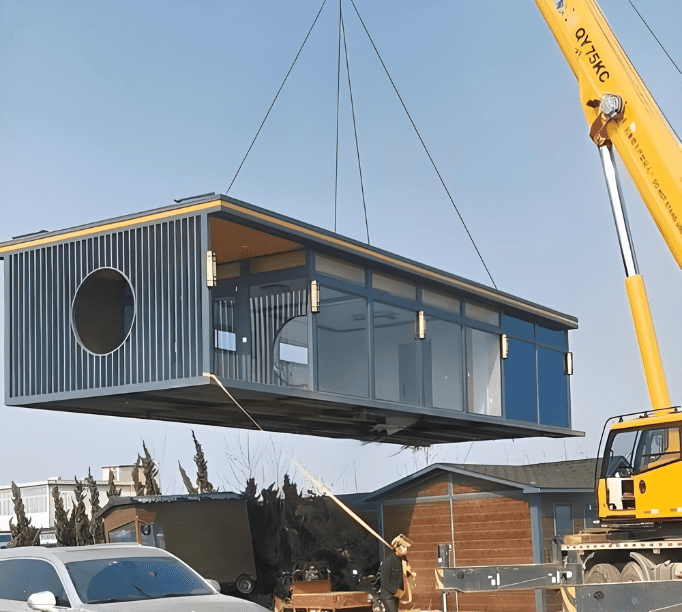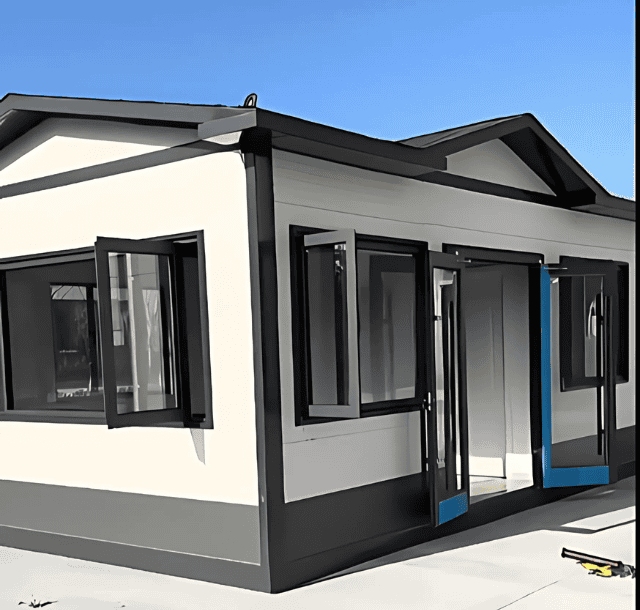When budgets tighten and timelines shrink, the question naturally arises: is modular construction actually cheaper? If you’re a developer or contractor navigating rising costs, labor shortages, or the need to scale faster, understanding the real economics behind modular building could unlock a competitive edge.
But here’s what most teams miss: modular isn’t always cheaper upfront—but when it is, it’s because the project is built around it from the start.
This article goes beyond the surface to break down where modular construction saves, where it doesn’t, and how to know if it’s the right move for your project.
What to Expect in This Blog:
What Does “Cheaper” Really Mean in Construction?
When you ask whether modular construction is cheaper, the first thing to clarify is: cheaper in what way? Are we talking about the upfront cost per square meter? The overall project cost? Or the long-term value over the building’s lifecycle?
In construction, “cheap” can be misleading. What looks less expensive on paper might cost you more in the long run—through delays, rework, or missed opportunities.
If you’re a developer or contractor, your real concern is likely total project efficiency. You care about how fast the building can be completed, how predictable the budget is, and when you can start generating revenue or handing over the project.
So when we talk about cost in modular construction, we need to consider a broader view:
- Construction timeline — how fast can it be built and delivered?
- Labor requirements — how much workforce do you actually need on-site?
- Material use and waste — how efficiently are resources used?
- Cash flow impact — can you start monetizing the building sooner?
In short, “cheaper” in modular construction doesn’t always mean a lower invoice at the start. It often means a better financial outcome by the end of the project.
Where Exactly Can Modular Construction Save You Money?
If you’re comparing modular construction to traditional building methods, don’t just look at the price per square meter. The savings often come from how the project is executed—not just how it looks on a budget sheet.
Here’s where modular gives you real cost advantages:
1. Faster Construction Timeline
Because most of the work happens in a factory while site preparation is underway, you cut weeks—or even months—off your schedule. That means faster handover, earlier revenue, or quicker project turnover.
2. Lower On-Site Labor Costs
Factory-based construction needs fewer workers on-site. You reduce costs tied to daily site operations, travel, housing, and coordination. In tight labor markets, this can make a big difference.
3. Less Waste, Better Material Control
Materials are cut and assembled with precision in a controlled environment. There’s less over-ordering, less damage, and fewer mistakes—meaning less money lost on waste and rework.
4. Fewer Delays and Disruptions
Factory production is unaffected by rain, snow, or heat. Projects stay on schedule, and your budget stays intact. That also reduces the need for costly extensions or contingency planning.
When all of these factors work together, they don’t just save money—they help you run a leaner, more predictable project from start to finish.
Does It Always Cost Less Than Traditional Construction?
Not always. That’s the honest answer.
Modular construction isn’t automatically the cheaper choice in every scenario. It depends on your project type, scale, location, and how much repetition is involved in the design. For some projects, especially small, one-off, or highly customized buildings, the cost of transportation, crane installation, and factory coordination can outweigh the savings.
But for the right kind of project, the financial benefits are clear.
Modular construction tends to work best when:
- Your design is repeatable. Projects with multiple identical units—like student housing or hotel rooms—are ideal for mass production.
- You’re under pressure to deliver fast. In time-sensitive builds, like emergency clinics or staff housing, the speed of modular makes up for any additional logistics cost.
- You’re building in remote or high-labor-cost regions. If on-site labor is expensive or hard to access, factory-built modules can be far more cost-efficient.
The bottom line: modular saves money when the project is designed to take full advantage of it. If your project fits that model, the numbers will work in your favor.
What Are the Hidden Costs You Should Know About?
Modular construction can be cost-effective, but like any method, it comes with trade-offs. If you’re not aware of them early on, these costs can catch you by surprise.
Transportation and crane installation are two of the biggest variables. Moving large modules from factory to site—and placing them precisely—requires careful logistics. If your site is far from the production facility, those costs can escalate quickly.

Site preparation is another area often overlooked. Just because the modules are built off-site doesn’t mean the foundation, utilities, and access roads build themselves. That groundwork still needs to follow traditional construction processes—and timelines.
Then there’s customization. The more you move away from standardized module designs, the more time and engineering is needed. That adds design cost, production complexity, and in some cases, delay.
Lastly, local code compliance can add friction. Different regions have different rules, and not every modular provider can easily adapt. If you’re building across jurisdictions, this can become a hidden layer of risk.
None of these issues make modular a bad choice. But understanding them from the start will help you plan smarter, budget more accurately, and choose the right supplier for your project.
When Does Modular Construction Make the Most Financial Sense?
Not every project is built for modular—but when the conditions are right, the savings can be significant. The key is to know what those conditions look like.
If your project is time-sensitive, modular construction gives you a clear edge. Think about temporary housing, clinics, or school buildings that need to open on a fixed date. In those cases, every week you save in construction translates directly into business value.
If you’re working on repetitive units, like hotel rooms, dormitories, or apartment blocks, modular is almost always more cost-efficient. Standardization reduces design time, production waste, and on-site complexity—all of which lower your costs.
And if you’re building in a remote location where skilled labor is hard to find, factory-built modules can be a game-changer. Instead of flying in workers and managing costly site logistics, you shift the complexity to a controlled, centralized facility.
In short, modular makes the most financial sense when speed, scale, or site conditions create pressure. If your project checks any of those boxes, it’s worth running the numbers.
Real-World Cost Comparison: Modular vs Traditional
Let’s say you’re planning a mid-size workforce housing project—about 60 units, each 25 square meters. You need the buildings up quickly, and every month of delay means added labor costs and postponed revenue.
With traditional construction, you’re likely looking at:
- Around 9–10 months for full delivery
- Cost per square meter: $1,200–$1,400, depending on location
- On-site labor for almost every phase, from structure to finishes
- Exposure to weather delays and unpredictable subcontractor schedules
Now take the modular approach for the same project:
- Factory production and site work happen in parallel
- Full delivery possible in 5–6 months
- Cost per square meter: $1,000–$1,250, depending on design complexity and transport
- Labor demand drops sharply after foundations are complete
Even if the upfront cost per square meter seems similar, the real value lies in the time saved, the smoother coordination, and the earlier use of the building. That means faster return on investment and fewer financial surprises.
Additional Financial Benefits to Consider
Cost savings from modular construction don’t stop at materials and labor. In many cases, the real value lies in what happens around the build—not just within it.
For developers, faster delivery means earlier occupancy. That improves cash flow and reduces the time your capital is tied up. If you’re financing the project, every month saved could mean lower interest payments and earlier revenue generation.
There’s also less disruption to surrounding businesses and infrastructure, especially in dense urban areas. That can save on permitting delays, neighborhood complaints, and indirect costs like temporary road closures or noise control measures.
And don’t overlook the sustainability factor. Modular projects often produce less waste and can more easily meet green building certifications. In some regions, that can unlock tax benefits, expedited approvals, or better financing terms.
In short, modular construction may not just reduce your costs—it may also increase the total value of your project in ways you hadn’t accounted for.
Is Modular the Right Fit for Your Next Project?
Modular construction isn’t a universal cost-cutting solution—but when aligned with the right project conditions, it delivers savings that go beyond the surface. Faster timelines, tighter cost control, reduced waste, and earlier revenue are just part of the equation. The real opportunity lies in designing your project to work with the modular process—not against it.
As a developer or contractor, your edge comes from making smart, context-driven decisions. If your next project demands speed, scale, or operational efficiency, modular may offer more than just a different building method—it could be your most strategic cost advantage.
SteelPRO PEB delivers modular and steel structure solutions to developers and contractors worldwide—faster, smarter, and built to scale.If your next project demands speed, predictability, or better cost control, let’s talk. Request a project-specific cost insight from our team.

